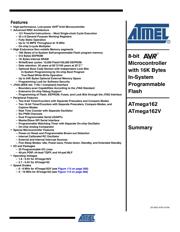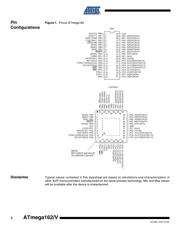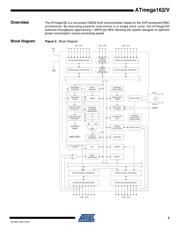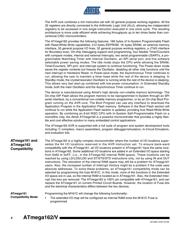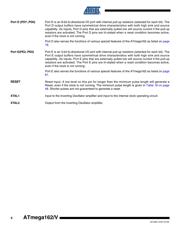Datasheet 搜索 > 微控制器 > ATMEL(爱特美尔) > ATMEGA162V-8PI 数据手册 > ATMEGA162V-8PI 用户编程技术手册 5/22 页
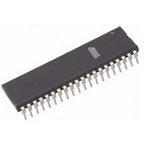
 器件3D模型
器件3D模型¥ 0
ATMEGA162V-8PI 用户编程技术手册 - ATMEL(爱特美尔)
制造商:
ATMEL(爱特美尔)
分类:
微控制器
封装:
DIP-40
Pictures:
3D模型
符号图
焊盘图
引脚图
产品图
页面导航:
导航目录
ATMEGA162V-8PI数据手册
Page:
of 22 Go
若手册格式错乱,请下载阅览PDF原文件

5
2513KS–AVR–07/09
ATmega162/V
• The timed sequence for changing the Watchdog Time-out period is disabled. See “Timed
Sequences for Changing the Configuration of the Watchdog Timer” on page 56 for details.
• The double buffering of the USART Receive Registers is disabled. See “AVR USART vs.
AVR UART – Compatibility” on page 168 for details.
• Pin change interrupts are not supported (Control Registers are located in Extended I/O).
• One 16 bits Timer/Counter (Timer/Counter1) only. Timer/Counter3 is not accessible.
Note that the shared UBRRHI Register in ATmega161 is split into two separate registers in
ATmega162, UBRR0H and UBRR1H. The location of these registers will not be affected by the
ATmega161 compatibility fuse.
Pin Descriptions
VCC Digital supply voltage
GND Ground
Port A (PA7..PA0) Port A is an 8-bit bi-directional I/O port with internal pull-up resistors (selected for each bit). The
Port A output buffers have symmetrical drive characteristics with both high sink and source
capability. When pins PA0 to PA7 are used as inputs and are externally pulled low, they will
source current if the internal pull-up resistors are activated. The Port A pins are tri-stated when a
reset condition becomes active, even if the clock is not running.
Port A also serves the functions of various special features of the ATmega162 as listed on page
72.
Port B (PB7..PB0) Port B is an 8-bit bi-directional I/O port with internal pull-up resistors (selected for each bit). The
Port B output buffers have symmetrical drive characteristics with both high sink and source
capability. As inputs, Port B pins that are externally pulled low will source current if the pull-up
resistors are activated. The Port B pins are tri-stated when a reset condition becomes active,
even if the clock is not running.
Port B also serves the functions of various special features of the ATmega162 as listed on page
72.
Port C (PC7..PC0) Port C is an 8-bit bi-directional I/O port with internal pull-up resistors (selected for each bit). The
Port C output buffers have symmetrical drive characteristics with both high sink and source
capability. As inputs, Port C pins that are externally pulled low will source current if the pull-up
resistors are activated. The Port C pins are tri-stated when a reset condition becomes active,
even if the clock is not running. If the JTAG interface is enabled, the pull-up resistors on pins
PC7(TDI), PC5(TMS) and PC4(TCK) will be activated even if a Reset occurs.
Port C also serves the functions of the JTAG interface and other special features of the
ATmega162 as listed on page 75.
器件 Datasheet 文档搜索
AiEMA 数据库涵盖高达 72,405,303 个元件的数据手册,每天更新 5,000 多个 PDF 文件
